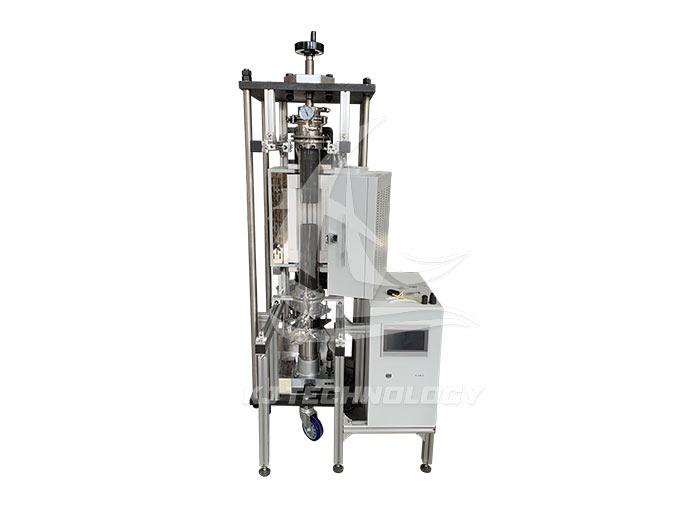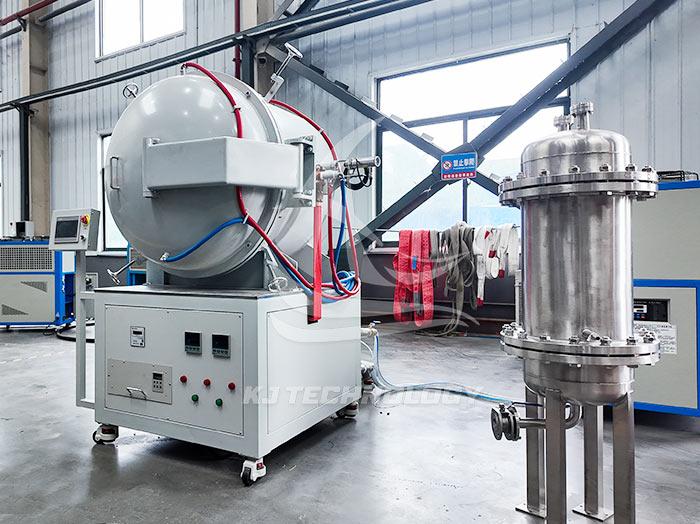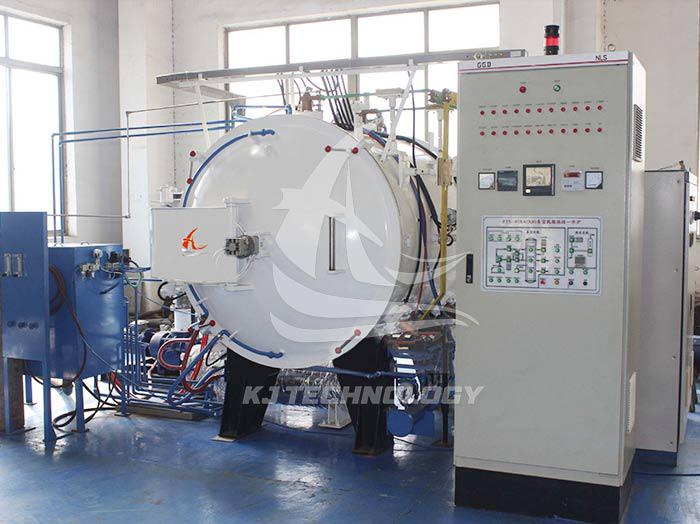Precautions for using graphite vacuum furnace in laboratory
 07-22-2025 Author: KJ technology
07-22-2025 Author: KJ technology
Due to high temperature, vacuum environment, and complex operating procedures, laboratory graphite vacuum furnaces must strictly follow operating procedures to ensure experimental safety, equipment stability, and data accuracy.
1. Preparation before operation
Equipment inspection
Appearance inspection: Confirm that the furnace body, furnace door, and observation window are free of cracks or damage, and that the sealing ring is not aged or deformed.
Vacuum system inspection: Check the oil level of the vacuum pump (if the oil level of the mechanical pump needs to be above the scale line), and test whether the readings of the vacuum gauge and pressure gauge are normal.
Cooling system inspection: Ensure that the water inlet of the water-cooled jacket is unobstructed, the water temperature is ≤ 35 ℃, and the water pressure is stable (usually 0.1-0.3MPa).
Electrical system inspection: Check if the power and grounding wires are intact to avoid the risk of electrical leakage.
sample preparation
Clean the sample: Remove impurities such as oil stains and oxides from the surface of the sample to prevent contamination of the furnace.
Size matching: The sample size should be smaller than the effective space of the furnace (for example, for a furnace with a diameter of 160mm × 160mm, the sample diameter should be ≤ 150mm).
Material compatibility: Avoid using materials that react with graphite (such as strongly oxidizing substances) to prevent furnace corrosion.
Environmental requirements
Ventilation conditions: Ensure good ventilation in the laboratory and avoid the accumulation of high-temperature gases or volatile substances.
Keep away from flammable materials: Organic solvents, gas cylinders, and other flammable materials should not be placed within 1 meter around the furnace.
2. Operation process specification
Sample installation and sealing
Handle with care: Use specialized tools (such as graphite pliers) to collect samples and avoid colliding with the inner wall of the furnace.
Uniform distribution: The sample should be placed in the center of the furnace to avoid uneven temperature caused by local overheating.
Sealing inspection: After closing the furnace door, manually rotate the locking device to confirm that the sealing ring is completely in contact with the furnace door.
Vacuum pumping and inflation
Gradual vacuuming:
First, turn on the mechanical pump to draw low vacuum (such as 10 ⁻¹ Pa), then start the Roots pump or diffusion pump to draw high vacuum (such as 10 ⁻⁴ Pa).
During the vacuuming process, observe the reading of the vacuum gauge. If there is no change for a long time, check the leakage point (such as flange connection or observation window seal).
Inflatable protection:
If inert gas protection (such as argon) is required, inflate to atmospheric pressure before opening the furnace door to avoid air backflow.
The inflation rate should be slow (≤ 0.5L/min) to prevent the sample from being damaged by airflow impact.
Heating and insulation
Segmented heating:
Low temperature range (<500 ℃): Heating rate ≤ 10 ℃/min to prevent thermal stress cracking of the sample.
High temperature section (>1000 ℃): Heating rate ≤ 5 ℃/min to ensure furnace temperature uniformity.
Insulation control:
The insulation time needs to be adjusted according to the thickness of the material (for example, a 10mm thick sample needs to be insulated for 2 hours).
Regularly record the temperature curve during the insulation process, and adjust the heating power if the deviation exceeds ± 5 ℃.
Cooling and Sampling
Natural cooling: After the high-temperature experiment, it is necessary to naturally cool to below 200 ℃ before opening the furnace door to avoid rapid cooling causing furnace cracking.
Forced cooling: If rapid cooling is required, the air cooling system (such as nitrogen cooling) can be turned on, but the pressure must be controlled to be ≤ 0.2MPa.
Sampling protection: Wear heat-resistant gloves (temperature resistance ≥ 800 ℃), use long handled tools to remove samples, and prevent burns.
3. Safety protection measures
Personal Protection
Wear equipment: lab coat, heat-resistant gloves, goggles, gas mask (when handling toxic substances).
Prohibited operation: Long hair should be tied up, and wearing jewelry or loose clothing near the furnace body is prohibited.
Emergency Management
Leakage accident: Immediately cut off the power supply, use a dry powder fire extinguisher to extinguish the initial fire, and prohibit using water to extinguish the fire.
Vacuum leakage: Quickly shut down the vacuum pump, turn on the ventilation system, and evacuate personnel to a safe area.
High temperature burns: Immediately rinse the wound with running cold water for 15 minutes, apply burn ointment, and seek medical attention.
equipment protection
Overtemperature protection: Set the upper temperature limit (such as 2200 ℃), and automatically cut off the heating power when exceeded.
Water pressure alarm: Install a water pressure sensor to trigger an audible and visual alarm and shut down when the water pressure is insufficient.
Overload protection: Install a current transformer to automatically cut off power when the current exceeds the rated value.
4. Maintenance and upkeep
Daily cleaning
Furnace cleaning: After each experiment, use a soft bristled brush to remove graphite debris to avoid residue affecting the next experiment.
Sealing ring maintenance: Regularly apply vacuum grease to prevent the sealing ring from drying out and cracking.
Observation window wiping: Use a dust-free cloth dipped in alcohol to clean and avoid scratches that may affect observation.
Regular maintenance
Vacuum system: Replace the mechanical pump oil and clean the oil mist filter every 3 months.
Heating element: Check the oxidation status of the graphite rod every six months, and replace it if the thickness of the oxide layer exceeds 2mm.
Cooling system: Clean the water-cooled jacket scale every year and test the water flow rate (≥ 2L/min).
Long term discontinuation
Drying treatment: Vacuumize to 10 ⁻ Pa before stopping, and fill with dry nitrogen for protection.
Moisture proof storage: The furnace body is covered with a dust cover and stored in a dry environment (humidity ≤ 60%).








